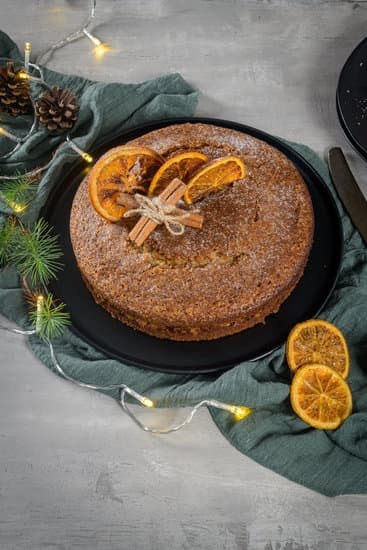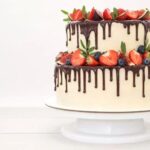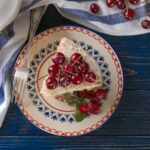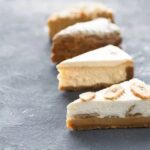Are you looking to elevate your cake decorating skills? Learn how to decorate frosting on cake for professional-looking results. Frosting plays a crucial role in enhancing the appearance and taste of a cake, making it an essential aspect of the decorating process. Whether you’re a beginner or more experienced, mastering the art of frosting can take your cakes to the next level.
Choosing the right type of frosting is key to achieving the desired aesthetic and texture for your cake. From buttercream to fondant, royal icing, or cream cheese frosting, each variety offers unique characteristics that contribute to different decorating techniques and styles. Understanding how to select and work with various types of frosting is fundamental to creating visually appealing cakes.
In addition to selecting the appropriate frosting, proper preparation of the cake itself is vital for successful decorating. This involves techniques such as leveling, crumb coating, and chilling, which provide a smooth surface for applying frosting. By learning these foundational steps, you can set the stage for flawless cake decoration and presentation. Stay tuned as we explore useful tools, creative techniques, and troubleshooting tips for achieving stunning frosted cakes.
Choosing the Right Type of Frosting
When it comes to choosing the right type of frosting for your cake, there are several options to consider. Each type of frosting has its own unique qualities and is suitable for different decorating techniques and tastes. Here are the most common types of frostings to consider:
- Buttercream: This classic frosting is made with butter, powdered sugar, and flavorings. It is soft, creamy, and easy to work with, making it ideal for piping designs and smooth finishes.
- Fondant: Fondant is a pliable icing that can be rolled out into a thin layer to cover cakes smoothly. It provides a blank canvas for intricate decorations and sculpted designs.
- Royal Icing: Made from egg whites and powdered sugar, royal icing dries hard and smooth, making it perfect for intricate details like lacework or delicate flowers.
- Cream Cheese Frosting: This tangy and creamy frosting is perfect for carrot cakes or red velvet cakes. It can be piped into decorative swirls or used for rustic finishes.
Before deciding on the type of frosting to use, consider the flavor profile of your cake, the decorating technique you plan to use, and the overall look you want to achieve. Experimenting with different types of frostings can open up a world of creative possibilities when it comes to decorating your cakes.
Understanding how to decorate frosting on a cake involves not only choosing the right type of frosting but also mastering the various techniques available. Whether you are new to cake decorating or an experienced baker looking for fresh ideas, exploring different types of frostings can elevate your creations to new levels of artistry.
Preparing the Cake for Frosting
Before you start decorating your cake with frosting, it’s essential to properly prepare the cake itself. This includes leveling the layers, applying a crumb coat, and chilling the cake to ensure a smooth and even application of frosting.
Here are the steps to prepare your cake for frosting:
1. Leveling: Use a serrated knife or a cake leveler to trim off any domed tops from the baked cake layers. This will ensure that your cake has an even surface for applying the frosting. Be sure to work carefully and slowly to achieve a level result.
2. Crumb Coating: Once your cake layers are leveled, it’s time to apply a thin layer of frosting all over the cake to seal in any loose crumbs. This initial layer, known as a crumb coat, will prevent crumbs from mixing into the final layer of frosting. Use an offset spatula to spread an even layer of frosting over the entire surface of the cake.
3. Chilling: After applying the crumb coat, place the cake in the refrigerator for at least 30 minutes to allow the frosting to set. Chilling the cake will make it easier to apply subsequent layers of frosting without disturbing the crumb coat.
By following these steps, you can ensure that your cake is well-prepared for decorating with frosting. Taking the time to properly level, crumb coat, and chill your cake will result in a beautifully frosted masterpiece that is ready for additional decorations and finishing touches.
Tools and Techniques for Frosting
Decorating a cake with frosting can be an enjoyable and creative process, but it requires the right tools and techniques to achieve a professional-looking result. One of the most important aspects of decorating frosting on a cake is using the right equipment. Piping bags, offset spatulas, and tips for smooth application are essential for creating intricate designs and achieving a smooth finish.
Piping bags are indispensable for creating decorative designs and patterns with frosting. They come in various sizes and materials, such as disposable plastic or reusable cloth, allowing for different types of decorations. Coupled with a variety of piping tips, they offer endless possibilities for decorating cakes, from simple lines and swirls to more complex designs like rosettes and leaves.
Offset spatulas are another essential tool for frosting cakes. Their angled design allows for easy spreading and smoothing of frosting over the cake’s surface. This versatile tool is perfect for achieving a flawlessly even coating of frosting without disturbing the cake underneath. Additionally, offset spatulas are great for creating textured finishes or adding decorative swirls to the frosting.
In addition to piping bags and offset spatulas, utilizing specific tips and techniques can help achieve a smooth application of frosting on cakes. It is important to choose the right consistency of frosting – not too stiff or soft – to ensure ease of application and proper adherence to the cake surface. By practicing proper hand movements and pressure control when using piping bags or offset spatulas, decorators can achieve clean lines and sharp edges in their designs.
The careful selection of tools coupled with skillful techniques can elevate any amateur decorator into an experienced cake artist capable of producing stunning creations. In the next section, we will cover various decoration ideas that can be implemented using these tools and techniques.
| Tools | Function |
|---|---|
| Piping Bags | Create decorative designs and patterns with frosting |
| Offset Spatulas | Spread and smooth frosting over the cake’s surface; create textured finishes |
Decoration Ideas
Decorating a cake with frosting is an art form that allows you to showcase your creativity and personalize your baked creation. There are numerous ways to decorate a cake, but one of the most popular methods is by using piping designs, edible flowers, sprinkles, and fondant accents. In this section, we will explore different techniques and ideas for decorating your frosted cake to ensure it not only tastes delicious but also looks visually appealing.
When it comes to piping designs, the possibilities are endless. Whether you want to create intricate patterns, write a message, or add borders to your cake, investing in piping bags and various tips is essential. To create beautiful designs with precision, it’s important to practice hand control and experiment with different pressure levels while piping. This will allow you to perfect your technique and elevate the overall look of your cake.
In addition to piping designs, adding edible flowers can bring a touch of elegance and natural beauty to your frosted cake. Edible flowers such as violets, pansies, or rose petals can be used as decorative elements that complement the flavor of the frosting. It’s important to ensure that any flowers used for decoration are safe for consumption and have not been treated with chemicals.
Sprinkles and fondant accents are also popular choices for adding visual interest to frosted cakes. Sprinkles come in a variety of shapes, colors, and sizes which can easily enhance the overall appearance of the cake. On the other hand, fondant accents allow for intricate decorations such as sculpted flowers, characters or other creative shapes that can be added on top of the frosting.
| Decoration Ideas | Description |
|---|---|
| Piping Designs | Create intricate patterns or write messages on your cake using different piping tips. |
| Edible Flowers | Add elegance and natural beauty by using safe-to-eat flowers like violets or rose petals. |
| Sprinkles | Enhance the overall appearance of your frosted cake with a variety of sprinkles in different shapes and colors. |
| Fondant Accents | Create sculpted decorations like flowers or characters using fondant that can be placed on top of the frosting. |
Creative Icing Techniques
Whether you’re making a cake for a special occasion or just looking to add a unique touch to your baking, creative icing techniques can take your cake decorating skills to the next level. Ombre, marbling, and textured finishes are all popular trends in the world of cake decoration, and learning how to master these techniques can help you create stunning and eye-catching desserts.
Ombre Icing
Ombre icing involves creating a gradient effect with different shades of the same color. To achieve this look, start by preparing a batch of buttercream frosting and dividing it into several bowls. Add increasing amounts of food coloring to each bowl, creating a light-to-dark progression.
Then, use an offset spatula to blend the colors together on the cake, starting with the lightest shade at the top and gradually transitioning to the darkest shade at the bottom. This technique adds a visually striking element to your cake and is sure to impress any guests.
Marbling Techniques
Marbled icing creates a beautiful swirling effect on your cake that mimics natural stone or marble. To achieve this look, start by applying different colors of buttercream frosting in random patches onto the cake. Then, use a clean offset spatula or a toothpick to gently swirl the colors together, creating a marbled effect. The key is not to overmix the colors so that distinct swirls are visible, giving your cake an elegant and sophisticated finish.
Textured Finishes
Adding texture to your cake’s frosting can create visual interest and add depth to your design. One way to achieve textured finishes is by using different piping tips or tools to create patterns such as ruffles, rosettes, or basketweave designs. You can also experiment with stencils or impression mats to create embossed patterns on your frosting. These techniques allow you to customize your cake’s appearance and add intricate details that will elevate your overall design.
By mastering these creative icing techniques – ombre, marbling, and textured finishes – you can take your cake decorating skills to new heights and impress friends and family with beautifully decorated desserts that look as amazing as they taste.
Troubleshooting Common Frosting Problems
Frosting a cake can be a fun and creative process, but it can also come with its fair share of challenges. Whether you are using buttercream, fondant, royal icing, or cream cheese frosting, it’s important to be prepared for common frosting problems that may arise during the decorating process. Here are some troubleshooting tips to help you overcome cracking, air bubbles, and melting when decorating your cake.
Cracking
One common issue when frosting a cake is cracking in the icing. This can occur for a variety of reasons such as overmixing your frosting, using an insufficient amount of liquid in the recipe, or applying the frosting too thickly. To avoid cracking, make sure to follow your recipe carefully and avoid overmixing the ingredients. Additionally, consider adding a thin layer of simple syrup to the cake before applying the frosting to ensure moisture and prevent cracking.
Air Bubbles
Air bubbles in frosting can create an uneven and unappealing appearance on your cake. To prevent air bubbles from forming, make sure to properly mix your frosting and use a spatula to gently press out any air pockets as you apply the frosting. You can also try tapping the filled piping bag on the counter to release any trapped air before piping decorations onto your cake.
Melting
Another common issue is melting frosting, especially in warm or humid conditions. If you notice your frosting starting to melt or lose its shape while decorating, try chilling your cake or working in a cooler environment. Additionally, consider using shortening instead of butter in your recipe for more stable results in warmer temperatures.
By keeping these troubleshooting tips in mind while decorating your cakes, you can ensure that your frosting remains smooth and flawless throughout the entire process.
Final Touches
In conclusion, mastering the art of decorating frosting on a cake is a skill that can elevate your baking game to the next level. By understanding the importance of frosting in cake decoration and choosing the right type of frosting for your desired design, you can set yourself up for success.
Preparing the cake for frosting is also crucial, as it ensures a smooth and professional-looking finish. Additionally, utilizing the right tools and techniques for frosting application can make a world of difference in achieving a flawless result.
When it comes to decorating your frosted cake, the possibilities are endless. From piping designs and edible flowers to sprinkles and fondant accents, there are countless ways to add a personal touch to your creation. Get creative with icing techniques such as ombre, marbling, and textured finishes to make your cake truly stand out.
As with any culinary endeavor, troubleshooting common frosting problems is par for the course. Whether it’s dealing with cracking, air bubbles, or melting issues, being aware of these potential pitfalls will equip you to handle them with ease. Finally, adding finishing touches with garnishes and presentation techniques completes the overall look of your masterpiece. So go ahead – experiment with different decorations and have fun bringing your frosted cakes to life.
Frequently Asked Questions
How Do You Put Frosting on a Cake?
Frosting a cake involves using a spatula or offset spatula to spread a thick layer of frosting onto the top and sides of the cake. It’s important to start with a crumb coat before adding the final layer of frosting.
What Do You Use to Decorate a Cake With Icing?
When decorating a cake with icing, you can use piping bags and tips to create designs, borders, and lettering. Additionally, edible decorations like sprinkles, fondant shapes, chocolate shavings, and fresh fruit can add color and texture.
How Do You Decorate a Cake With Buttercream for Beginners?
Beginners can decorate a cake with buttercream by starting with simple techniques like smooth frosting with an offset spatula or creating textured swirls with a piping bag. Using different tips for piping can add more variety to the design. Practice is key to improving skills in buttercream cake decorating.

Welcome to our cake decorating blog! My name is Destiny Flores, and I am the proud owner of a cake decorating business named Cake Karma. Our mission is to provide delicious, beautiful cakes for all occasions. We specialize in creating custom cakes that are tailored specifically to each customer’s individual needs and tastes.





